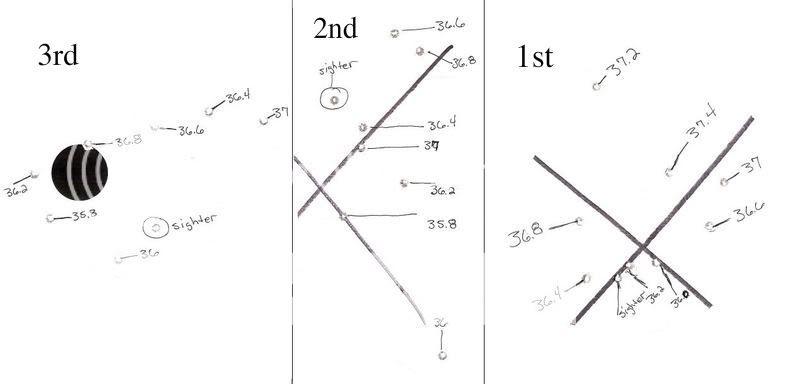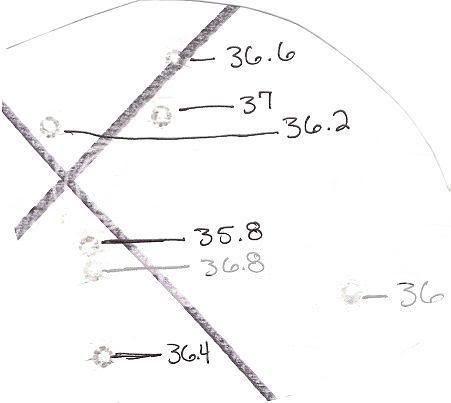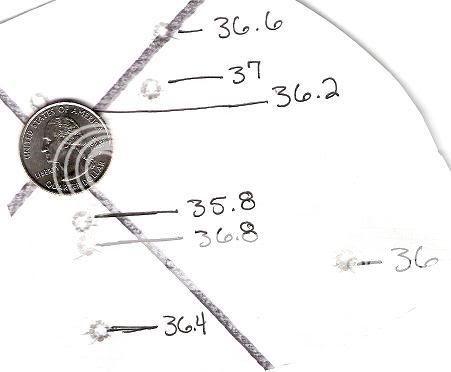You are using an out of date browser. It may not display this or other websites correctly.
You should upgrade or use an alternative browser.
You should upgrade or use an alternative browser.
Ladder test interpertation
- Thread starter Preda8or
- Start date
 Help Support Long Range Hunting Forum
Help Support Long Range Hunting Forum
boomtube
Well-Known Member
A little confused, as usual. Are the targets of the same load, fired on the same day? If so, it looks to me like you need to try another powder or primer or seating depth because of the lack of consistancy.
On the other hand, the right target suggests your starting load, 36 to maybe 36.3 would be worth pursuing. Even then, that's a really narrow accuracy window, or 'sweet spot." I prefer seeing hits with less dramatic changes as I approach and leave the sweet spots.
On the other hand, the right target suggests your starting load, 36 to maybe 36.3 would be worth pursuing. Even then, that's a really narrow accuracy window, or 'sweet spot." I prefer seeing hits with less dramatic changes as I approach and leave the sweet spots.
Last edited:
jpretle
Well-Known Member
Looks to me, like you have 2 nodes in the right target. Which velocity could you live w/ in relationship to the accuracy factor? 1/3' elevation is nothing to sneeze at for a 300yd group.
However, your 1st target contradicts your 2nd. Was every shot a 'good shot'? If not, I would be shooting this again. A component change may be in order---Primers, maybe?????
However, your 1st target contradicts your 2nd. Was every shot a 'good shot'? If not, I would be shooting this again. A component change may be in order---Primers, maybe?????
tx_shooter
Active Member
- Joined
- Jan 29, 2008
- Messages
- 25
I'll agree that on the right target there appears to be two nodes - as far as vertical dispersion goes. The biggest problem I see is that the left target doesn't have agreeing results. In fact, that target doesn't show any solid nodes for development. At this point I would double check my componets and process for case prep. Something is giving you some serious variance in pressures/ MV. Do you know what amount of jump this setup likes yet? I'd run a ladder test around the amount of jump - and use that data to set the OAL for your ladder test for powder amount. Just my 2 cents...
AJ Peacock
Well-Known Member
How accurate is the rifle with the best load you've ever shot in it?
If it is a sub 1MOA rifle, then the ladder may mean something. However, if the rifle is not necessarily that accurate, then the natural size of the group can overwhelm the ladder results. (I hope that made sense)
For example; if the changes of .2gr move the impact point 1/2 MOA, you would see a repeatable pattern with a super accurate rifle/shooter/conditions combination. But if the rifle/shooter/conditions combo is only capable of 1moa (or larger) groups, the 1/2 MOA change would be impossible to discern. If the .2gr change is only moving the impact 1/4 MOA, it would take a seriously accurate rifle to see the difference on a ladder.
I know you don't have a chrono, but without the velocity info. it's really tough to make an informed choice.
I agree with tx_shooter, pick a load and play with the seating depth (I'd probably load some at 36.7 and shoot 3 shot groups with different seating depths). Then after selecting the best seating depth, I'd do a ladder around 36.7 and see what it looked like.
Good luck,
AJ
If it is a sub 1MOA rifle, then the ladder may mean something. However, if the rifle is not necessarily that accurate, then the natural size of the group can overwhelm the ladder results. (I hope that made sense)
For example; if the changes of .2gr move the impact point 1/2 MOA, you would see a repeatable pattern with a super accurate rifle/shooter/conditions combination. But if the rifle/shooter/conditions combo is only capable of 1moa (or larger) groups, the 1/2 MOA change would be impossible to discern. If the .2gr change is only moving the impact 1/4 MOA, it would take a seriously accurate rifle to see the difference on a ladder.
I know you don't have a chrono, but without the velocity info. it's really tough to make an informed choice.
I agree with tx_shooter, pick a load and play with the seating depth (I'd probably load some at 36.7 and shoot 3 shot groups with different seating depths). Then after selecting the best seating depth, I'd do a ladder around 36.7 and see what it looked like.
Good luck,
AJ
I just got the barrel. After the first ladder test, I picked 36.1 grains and shot a 3 shot group at 300yds that measured .996 and thought great. Came home started reading more about the ladder test and a member said that a ladder test would not show the same results every time so I thought I would test it again and that's what got us here. the ladder's are not as big as there may appear, The first one measures 5.6" the second is 4.53" not including the bottom bullet(36gr) and the last one is 4.43". I have not messed much with the seating depth but they do seem to like some jump with this barrel.
AJ Peacock
Well-Known Member
So the gun is shooting well. I'd play with the seating depth a bit and decide "how good" is good enough. Certainly a .996" at 300yds is pretty darn good.
Good luck,
AJ
Good luck,
AJ
L
Lightvarmint
Guest
Hello,
I am sure some will disagree but here goes...... Probably the most accurate instrument you have in your toolbox is the micrometer or calipers. With that being said, keep the powder the same and do all the tweeking with the highly accurate calipers/micrometers.
Of course you will have to get comfortable with the pressure levels by keeping the seating depth constant (say .010 off the lands) and slowly increase the powder until you reach the pressure point where you want shoot your rifle. After you get where you are comfortable with the pressure, keep the powder the same and do all the tuning away from the lands in .005" increments until you find where the node starts for your barrel and keep going until you find where it stops. At that point, you will have defined the accuracy seating depth range for your gun and you should be basically done. Shoot inside this defined zone to find where the (1) accuracy is the best and (2) the velocity is the most consistent.
Most have powder scales that are + or - .1 grains and in the extreme, you could get almost .2 grains variance without seeing it and even much more dispersion when you actually are changing the powder charges in minute amounts. For the untrained, it looks as though there is an issue with the rifle when in reality, it could just be overlapping powder charges due to scale errors.....
For me, when I had the digital scale that was only good for .1 grains, I weighed the powder using the blinking method. Specifically, weigh the powder such that it JUST blinks to the correct value. This way you are minimizing the variance between powder charges. Of course, the easiest way is to get a more accurate scale (Acculab is accurate to .02 grains) and go -.000 and + .02 grains when working up loads.
FWIW, when using this method, we always get less than 10 FPS dispersion on velocity as well. The method really has been working great for us and you are welcome to use it. Who knows, you may even find a load that will shoot the shots into the same hole.
Hope this helps.
James
I am sure some will disagree but here goes...... Probably the most accurate instrument you have in your toolbox is the micrometer or calipers. With that being said, keep the powder the same and do all the tweeking with the highly accurate calipers/micrometers.
Of course you will have to get comfortable with the pressure levels by keeping the seating depth constant (say .010 off the lands) and slowly increase the powder until you reach the pressure point where you want shoot your rifle. After you get where you are comfortable with the pressure, keep the powder the same and do all the tuning away from the lands in .005" increments until you find where the node starts for your barrel and keep going until you find where it stops. At that point, you will have defined the accuracy seating depth range for your gun and you should be basically done. Shoot inside this defined zone to find where the (1) accuracy is the best and (2) the velocity is the most consistent.
Most have powder scales that are + or - .1 grains and in the extreme, you could get almost .2 grains variance without seeing it and even much more dispersion when you actually are changing the powder charges in minute amounts. For the untrained, it looks as though there is an issue with the rifle when in reality, it could just be overlapping powder charges due to scale errors.....
For me, when I had the digital scale that was only good for .1 grains, I weighed the powder using the blinking method. Specifically, weigh the powder such that it JUST blinks to the correct value. This way you are minimizing the variance between powder charges. Of course, the easiest way is to get a more accurate scale (Acculab is accurate to .02 grains) and go -.000 and + .02 grains when working up loads.
FWIW, when using this method, we always get less than 10 FPS dispersion on velocity as well. The method really has been working great for us and you are welcome to use it. Who knows, you may even find a load that will shoot the shots into the same hole.
Hope this helps.
James
BENNYBOOBOO
Well-Known Member
All three of your pictures posted with the vld's have the same node in common- 36.6/36.7.
Another offering that might be of some interest is Dan Newberry's article on Optimal Charge Weight. The principle between the OCW method and the ladder test are the same, but it is my opinion that the OCW method offers less room for error.
However somebody already said it: for 300 yards those are some good looking targets, no matter what the charge weight.
EH
Another offering that might be of some interest is Dan Newberry's article on Optimal Charge Weight. The principle between the OCW method and the ladder test are the same, but it is my opinion that the OCW method offers less room for error.
However somebody already said it: for 300 yards those are some good looking targets, no matter what the charge weight.
EH


